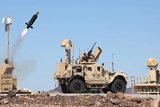Royal Marines tests LMM against Banshee
The Royal Marines has tested Thales’ Lightweight Multirole Missile (LMM) against aerial targets during an exercise in south Wales.
Air Defence Troop of Plymouth-based 30 Commando IX Group was the first sub unit to use the new LMM, testing it against a Qinetiq Target Systems Banshee aerial target at the Air Defence Range Manorbier in southwest Wales.
From a platform looking out to sea, the commandos used the laser-guided missiles to accurately hone in on their targets.
The missiles are fired from a small shoulder launcher, and the operator guides them using a joystick which controls a laser beam on which the projectile flies, travelling over distances of some 6km if required.
‘It gives us more utility across the battlefield and gives the brigade a different option,’ Capt James O’Rourke, Officer Commanding of Air Defence Troop, said.
The marines say thatLMM travels at half the speed of its predecessor, the High Velocity Missile that is currently used by the marines and Royal Artillery, providing greater accuracy against the targets.
‘It means we can start enabling attacks on targets that won’t be able to see us. It’s got a laser beam system as well and it’s a passive system so we won’t be spotted by the enemy when we pull the trigger,’ O’Rourke added.
Air Defence Royal Marines is the first sub unit to use this missile, and so far, 18 successful shots against the Banshee drone have been carried out.
‘I think in the future we’ll be attached to close combat rifle companies, pushing forward and potentially targeting unmanned aerial systems and unmanned aerial vehicles in the skies as opposed to sticking with fixed-wing rotary targets,’ O’Rourke added.
Related Equipment in Defence Insight
More from Land Warfare
-
![NATO and Europe step up UGV efforts]()
NATO and Europe step up UGV efforts
The effort to develop uncrewed ground vehicles (UGVs) is heating up with research efforts and exercises improving the speed of the process and the war in Ukraine is working as a proving ground for rapid development and fielding.
-
![Ireland’s Reamda develops new version of Riddler UGV]()
Ireland’s Reamda develops new version of Riddler UGV
The company's Riddler uncrewed ground vehicle (UGV) is designed to be small and light to allow easy deployment and the ability to access smaller areas such as bus or train aisles.
-
![Spain to invest billions of dollars on howitzers and other vehicles as it looks to select new tanks]()
Spain to invest billions of dollars on howitzers and other vehicles as it looks to select new tanks
The Spanish Government has outlined plans to purchase communications and cybersecurity capabilities but most notably amphibious combat vehicles, self-propelled howitzers (SPHs), bridge-laying vehicles and an effort to replace its tanks from 2040.
-
![What does Germany’s new tank joint venture mean for MGCS?]()
What does Germany’s new tank joint venture mean for MGCS?
Germany is Europe’s leading country for tank manufacture and until this month was committed to the Franco-German Main Ground Combat System (MGCS) which included tanks and other vehicles. Earlier this month, Germany and other European countries set up the Main ARmoured Tank of Europe (MARTE) project casting a shadow over the MGCS.
-
![CAVS rolls on as Denmark orders 129 vehicles]()
CAVS rolls on as Denmark orders 129 vehicles
Denmark signed the Technical Arrangement for the multinational Common Armoured Vehicle System (CAVS) in April this year. The order means the country will receive its first vehicle this year.
























